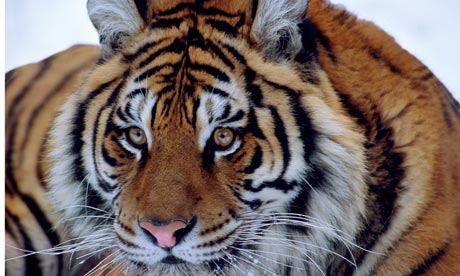 From The guardian
From The guardianSiberian tiger threatened by mystery disease
by PATRICK EVANS
Conservationists say an epidemic is destroying the big cats' ability to hunt and turning them into potential man-eaters
A mystery disease is driving the Siberian tiger to the edge of extinction and has led to the last animal tagged by conservationists being shot dead in the far east of Russia because of the danger it posed to people.
The 10-year-old tigress, known to researchers as Galya, is the fourth animal that has had a radio collar attached to it for tracking to die in the past 10 months. All had been in contact with a male tiger suspected of carrying an unidentified disease that impaired the ability to hunt. "We may be witnessing an epidemic in the Amur tiger population," said Dr Dale Miquelle, the Wildlife Conservation Society's (WCS) Russia director.
Galya had recently abandoned a three-week-old litter of cubs and come into the town of Terney looking for an easy meal. Following a series of all-night vigils by researchers, attempts to scare the tigress away failed. She was reported to the Primorsky State Wildlife Department as an official "conflict tiger", and a state wildlife inspector was called in to destroy her earlier this month.
"This tiger had lost its fear of humans – typically Amur tigers will never expose themselves for observation. It was like seeing someone you know turn into a vampire," Miquelle said.
Scientists are attempting to understand what compromised the tigress's ability to capture wild prey, which she had lived upon almost exclusively since birth. Her cubs, which were subsequently found dead at the den, are likely to have had their mother's disease transmitted to them through the placenta. "Initial necropsy results show an empty digestive tract, which is highly unusual. We're still waiting for results of further tests, but the abnormal behaviour suggests disease, possibly neurological," said Miquelle. "We are extremely concerned about the possibility of an epidemic that could be sweeping through this region. Animals we have studied extensively, and known well, have demonstrated radically changed behaviour, which is extremely disconcerting."
Weighing only 91kg at death – down from an estimated 140kg at full health – the tigress's death represents the end of an 11-year lineage of related "study" tigers, and leaves the WCS's Siberian Tiger Project with no radio-collared animals for the first time in 18 years. WCS Russia has tracked more than 60 tigers since inception in 1992.
In March this year, Miquelle raised the prospect of disease as a potential threat to an already endangered Siberian tiger population. WCS Russia reported in October 2009 that there had been a 40% decline in numbers since the last full survey in 2005, from 428 to as little as 252 adult tigers. The tiger's range has been reduced to a small pocket in the corner of the country within the region of Primorsky Krai.
Speaking at a conference in Vladivostok, Miquelle said that anything above a 15% mortality rate in adult females could kill off all Amur tigers. With around 150 adult females in the population, any more than 22 deaths of adult females per year may wipe out the species. Poaching accounts for about 75% of all Amur tiger deaths, with 12 to 16 adult females killed annually. "We're in a new era where disease could seriously affect the Amur tiger."
The Russian draft federal tiger conservation strategy has recently been amended to take account of disease, including a section on vaccination against canine distemper, a viral disease which is common in the Russian far east in domestic dogs and cats.
"The addition of disease-related deaths to existing sources of mortality could push this population over a tipping point," said Miquelle.
The federal strategy, which is being designed by a number of scientific groups including WCS Russia, is being prepared for the first global Tiger Summit due to take place in St Petersburg this September. Along with World Bank president Robert Zoellick, Vladimir Putin is due to preside over the conference.
WCS Russia hopes to recommence the capture of study tigers in September. "We aim to change the focus of why we study tigers, with a new emphasis on disease," said Miquelle. "The only consolation in this grisly process is that, for once, a serious threat is not originating from human actions, although even that, for now, is open to debate."
Thanks to Emma S for the link.







1 comment:
Siberian tigers and South China tigers are the most endangered cat species in the world. In the wild they were fewer than three thousand, and their number is constantly decreasing. People hunt them for their fur and because of traditional Asian medicine. It would be a shame that these amazing animals are gone forever, and remain only in stories.
Post a Comment